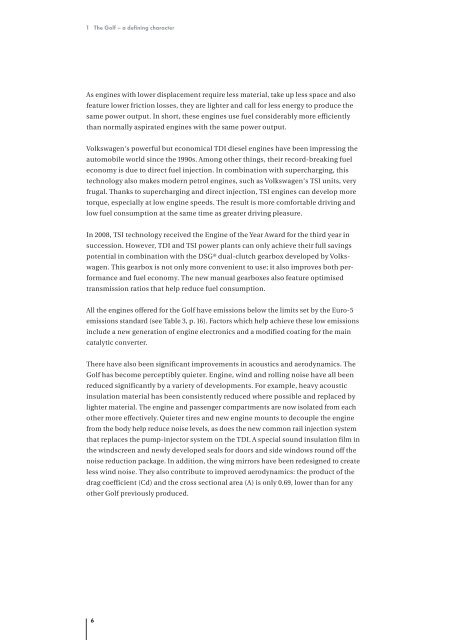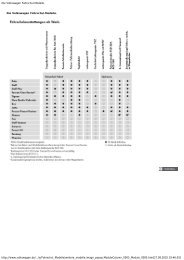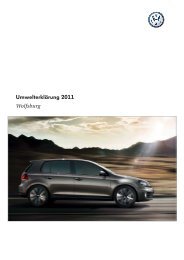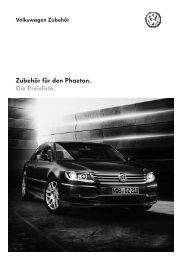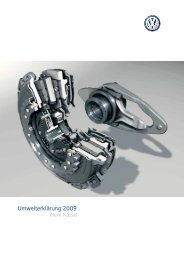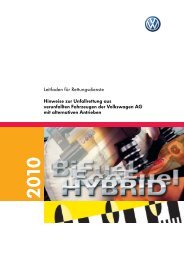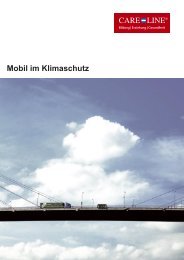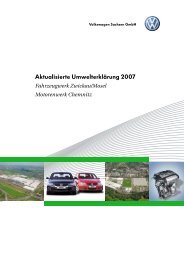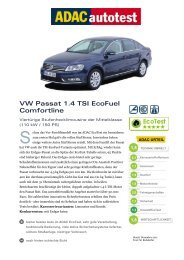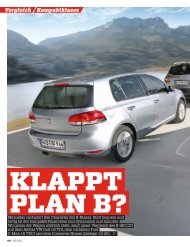Detailed Version - Volkswagen AG
Detailed Version - Volkswagen AG
Detailed Version - Volkswagen AG
Create successful ePaper yourself
Turn your PDF publications into a flip-book with our unique Google optimized e-Paper software.
1 The Golf – a defining character<br />
As engines with lower displacement require less material, take up less space and also<br />
feature lower friction losses, they are lighter and call for less energy to produce the<br />
same power output. In short, these engines use fuel considerably more efficiently<br />
than normally aspirated engines with the same power output.<br />
<strong>Volkswagen</strong>‘s powerful but economical TDI diesel engines have been impressing the<br />
automobile world since the 1990s. Among other things, their record-breaking fuel<br />
economy is due to direct fuel injection. In combination with supercharging, this<br />
technology also makes modern petrol engines, such as <strong>Volkswagen</strong>‘s TSI units, very<br />
frugal. Thanks to supercharging and direct injection, TSI engines can develop more<br />
torque, especially at low engine speeds. The result is more comfortable driving and<br />
low fuel consumption at the same time as greater driving pleasure.<br />
In 2008, TSI technology received the Engine of the Year Award for the third year in<br />
succession. However, TDI and TSI power plants can only achieve their full savings<br />
potential in combination with the DSG ® dual-clutch gearbox developed by <strong>Volkswagen</strong>.<br />
This gearbox is not only more convenient to use; it also improves both performance<br />
and fuel economy. The new manual gearboxes also feature optimised<br />
transmission ratios that help reduce fuel consumption.<br />
All the engines offered for the Golf have emissions below the limits set by the Euro-5<br />
emissions standard (see Table 3, p. 16). Factors which help achieve these low emissions<br />
include a new generation of engine electronics and a modified coating for the main<br />
catalytic converter.<br />
There have also been significant improvements in acoustics and aerodynamics. The<br />
Golf has become perceptibly quieter. Engine, wind and rolling noise have all been<br />
reduced significantly by a variety of developments. For example, heavy acoustic<br />
insulation material has been consistently reduced where possible and replaced by<br />
lighter material. The engine and passenger compartments are now isolated from each<br />
other more effectively. Quieter tires and new engine mounts to decouple the engine<br />
from the body help reduce noise levels, as does the new common rail injection system<br />
that replaces the pump-injector system on the TDI. A special sound insulation film in<br />
the windscreen and newly developed seals for doors and side windows round off the<br />
noise reduction package. In addition, the wing mirrors have been redesigned to create<br />
less wind noise. They also contribute to improved aerodynamics: the product of the<br />
drag coefficient (Cd) and the cross sectional area (A) is only 0.69, lower than for any<br />
other Golf previously produced.<br />
6


